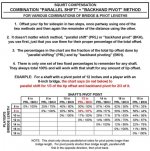iMAKE NO CLAIM TO UNDERSTANDING ANYTHING ABOUT POOL
BUT I SAW DR DAVE MAKE A DEMONSTRATION OF REVO AND SEVERAL OTHER SHAFTS AND I COULD NOT SEE THE DIFFERENCE
I HAVE HITMAY CUES,SOME DRAW EASIER BUT I JUST CAN NOT SEE ANY REASON TO SWITCH
FROM MAPLE
NOT BECAUSE I AM CHEAP,THAT DOES COME INTO PLAY,BUT I CAN NOT SEE ANY REASON TO SWITCH
Some shots are more forgiving on the Revo (can't speak for the cuetec/becue/mezz) – especially for 9-ball/10-ball. Long distance drag shots with side spin for instance, or say having to stun the cue ball across the table with very little angle to work with. Generally more power compared to most low deflection shafts –*but for someone using maple shafts with a strong taper power is usually not an issue; if the deflection doesn't bother you then you're golden.
